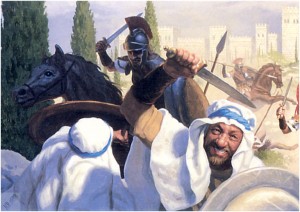The Jewish-dominated region of Judea rebelled against the religious oppression of the Seleucid king, Antiochus IV, and forged an independent nation-state in one of the world’s first successful guerrilla campaigns. For about a century after Alexander the Great had conquered the Persian Empire, the coastal zone southwest of Syria became the pivot point of the rivalry between the Ptolemaic (Egypt-based) and Seleucid (Syria-Asia Minor) successor regimes. By 170 B. C. E., Antiochus III and his sons Seleucis IV and Antiochus IV Epiphanes, rulers of the Seleucid Empire, understood that they would have to confront the expanding influence of Rome. Antiochus IV felt that it was crucial to forge religious unity throughout his dominion, integrating all the various gods with Olympian Zeus at their head. Especially significant was Jewish-dominated Judea, the strategic fulcrum covering southern invasion routes. As a result, he violated the promise of his father Antiochus III to respect the religious autonomy of the Jews. To this end, Antiochus took sides in a power struggle between rival high priests in Jerusalem, as a pretext to intervene openly in Jewish religious matters. This confrontation culminated when Antiochus Epiphanes occupied Jerusalem. He destroyed the city walls, raided the Temple treasury to fund his dwindling war chest, and decreed the abolition of Jewish separatism. He next converted the temple into a pagan shrine, setting up a fortress opposite, and forbade the hallowed practices of circumcision and Sabbath observance.
In 168 B. C. E., Seleucid troops set up pagan altars in the countryside and, in the village of Modi’in, ordered a lower ranking priest, Mattathias, to ritually eat pig’s flesh. He refused and killed another villager who complied, leading the townsfolk in a massacre of the Greek garrison, thereby starting the revolt. Mattathias withdrew to a concealed and well-guarded training camp for irregular forces in the foothills near Gophna, northwest of modern Ramallah. The training went on for a year prior to conducting operations and included politico-religious indoctrination and the establishment of friendly ties with the populace in key localities, where they established logistical bases, intelligence networks, safe houses, and weapons hoards. The moribund Mattathias designated one of his sons, Judas (who became known as Maccabee, or “the Hammer”) to take over for him.
In a series of brilliant guerrilla actions, Judas defeated a succession of Syrian generals. His most renowned victories occurred at Beth Horon Pass (166 B. C. E.), Emmaus (166 B. C. E.), and Beth Zur, in the vicinity of Hebron (165 B. C. E.).His success is attributed to the first recorded instances of successful irregular warfare: hit-and-run night raids, ambushes at defiles, and attacks on rear-echelon units and individuals. After Beth-Zur, Judas captured Jerusalem, liberating the temple, though a Seleucid garrison held out in the citadel.
In 165-164 B. C. E., Judas extended his control over most of Judea, maintaining a close siege of the Syrian troops in the citadel. Since Antiochus was preoccupied with a triumphant campaign in the East, it was left to the Syrian regent Lysias to lead an invasion of Judea to recapture Jerusalem. After defeating the Jews at Beth Zacharia, he had to cut the campaign short to suppress a revolt in Syria in 164 B. C. E..
In 164 B. C. E., Bacchides, in charge of Seleucid forces in Judea, defeated Judas, driving him from Jerusalem. Quickly rebounding from this reverse, Judas took the offensive and, in 160 B. C. E., routed and killed the Syrian general Nicanor at Adasa, close to his earlier victory at Beth Horon. Judas himself was killed in battle by Bacchides at Elasa later that year. Leadership of the Maccabees passed to Judas’s brother, Jonathan, who continued guerrilla campaigns against the Syrians. In 143 B. C. E., Syrian troops, in league with alienated Jews, captured and eventually executed Jonathan at Ptolemais (Acre). Subsequently, the Seleucids recognized another of Judas’s brothers, Simon, as king of Judea, establishing the Hasmonean dynasty, which ended with the accession of Herod the Great, after his marriage to the last Hasmonean queen, Miriam.
References and further reading: Bar-Kochva, Bezalel. The Seleucid Army: Organization and Tactics in the Great Campaigns. Cambridge, UK: Cambridge University Press, 1976. —. Judas Maccabeus. The Jewish Struggle against the Seleucids. Cambridge, UK: Cambridge University Press, 1989. Farmer, William R. Maccabees, Zealots and Josephus: An Inquiry into Jewish Nationalism in the Greco-Roman Period. New York: Columbia University Press, 1956. Gichon, Mordechai, and Chaim Herzog. Battles of the Bible. 2d ed. London, Greenhill Books, Lionel Leventhal, 1997.
